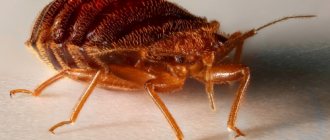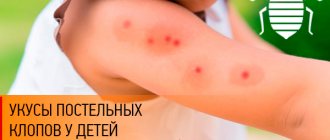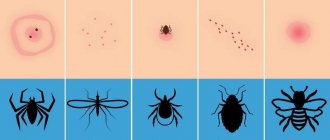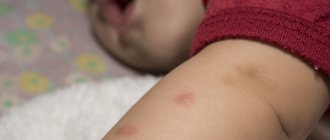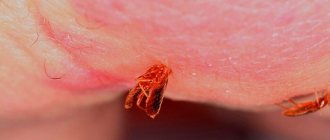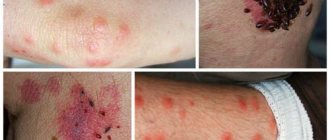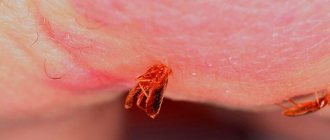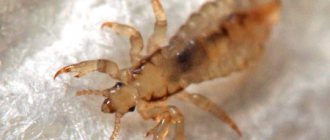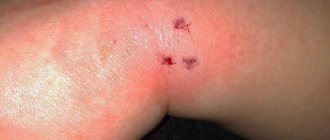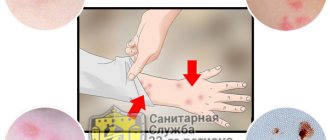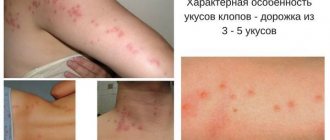Bedbugs are blood-sucking insects with a flattened oval body shape ranging from 3 to 8 mm in length. The color and size of bedbugs depends on their age and degree of blood saturation. The adult individual is light brown to brown in color. After the bug drinks blood, the color can change from bright red to almost black. The average lifespan of bedbugs is from 1 to 1.5 years.
Bedbug bites are their way of feeding to support life. Bedbugs feed exclusively on the blood of people, birds and animals.
Unfortunately, in our time, no one is safe from the appearance of such extremely unpleasant insects as bed bugs. Stereotypes that these insects appear only in unsanitary conditions are long gone.
At the moment, a connection between bedbug bites and infection through a bite with various diseases has not been found. Nevertheless, bedbugs greatly poison our lives, interfering with restful sleep, thereby reducing productivity.
What do bedbug bites look like?
Every year the number of people suffering from bites of these parasites is growing. If, after waking up, you notice a lot of round red swellings on your body, do not rush to refer to a mosquito bite; perhaps parasites called “bugs” have come into your home.
The main difference is the massive, tightly spaced and grouped bites. Typically, bed bug bites are located in one line. The number of bites of one bug is also typical - 3 - 5 punctures of the skin at a distance of 2 - 4 centimeters from each other.
The difference between bedbug bites and an allergic reaction
In most cases, bedbug bites are misdiagnosed as scabies or an allergy to something. But there are significant differences between a bedbug bite and an allergic reaction.
- The redness from the bite is not continuous, it is located in a path.
- The allergic rash is spread over the entire surface of the body, and not in any individual open areas.
- The bite mark, as a rule, does not change over time; the size, color and shape of the allergy rash can change quite quickly.
- Other family members did not notice anything suspicious on their skin, unlike the victim.
The difference between bedbug bites and the bites of other insects, such as mosquitoes, fleas, etc.
It is somewhat more difficult to distinguish a bedbug bite from the bites of other insects, since all bites look approximately the same - a red spot accompanied by itching.
From a mosquito bite, a bug bite differs in a more defined shape. Flea bites are distributed randomly on certain areas of the skin (most often the affected areas are the legs, up to the knees), while bedbug bites are located approximately in one line. The pain from a midge bite is stronger, but the bite wound itself is smaller, with a drop of dried blood in the middle. Bites of large insects (bees, hornets, wasps) are always remembered by a person because of acute pain. Bed bugs bite unnoticed and the bite can be detected after some time.
Symptoms of bed bug bites
Bedbugs mainly bite exposed areas of the body: legs, arms, neck, face, shoulders. The bite itself can manifest itself differently in each person.
Typically, the main symptoms of a bedbug bite include severe redness, round swelling, and severe and irritating itching. Unlike mosquito bites, bedbug bites are more painful and more clearly defined. In some cases, an allergic reaction is possible, but this is rare.
Bedbug bite marks are a reaction to the saliva that the bedbug secretes before the bite so that the blood is better prepared for intake. Because of this, the bite mark of a bedbug lasts longer than that of other insects.
What’s interesting is that if you are bitten by an adult bedbug, you may not see a reaction right away. If the animal is young, then most likely the reaction will not take long to occur - it will manifest itself instantly. This is due to the fact that young bedbugs, unlike adults, are not able to secrete saliva, which contains a substance that acts as an anesthetic.
So, to summarize, the symptoms of bedbug bites are as follows:
- Redness
- Itching
- Swelling
- Grouped bites (3 - 5 skin punctures at a distance of 2 - 4 centimeters from each other).
Also, bedbugs have a special smell, because... they have odorous glands, the openings of which are located on the chest in adults, and on the abdomen in larvae. If you crush a bug, which is very difficult in principle, you can smell their specific smell. By the way, opinions differ regarding the smell: some believe that bedbugs smell of something sweet, like spoiled raspberries, others say cognac, and others claim that a room with bedbugs smells like almonds.
When and who do bedbugs bite first?
It is known that the activity of these parasites is concentrated at night and early morning hours, i.e. in the dark, when a person sleeps especially soundly. People notice the bites themselves only in the morning.
If your living space is heavily infested with bedbugs, hungry insects can bite not only at night, but also during the day, although this is not typical for them. Therefore, the faster you get rid of bed bugs, the faster you can be calm in your apartment.
The sensation of bed bug bites is often subjective and individual. For example, women and children most often complain about bites. Their skin is thinner and softer, therefore, the blood vessels are located closer, which attracts the bug.
Adult men are less sensitive to bites, and sometimes they may not notice them at all. Rumors that bedbugs bite people selectively, and especially those who are carriers of certain blood groups, are erroneous. Bedbugs bite everyone, but the reaction to a bite varies from person to person. So, there is no connection between the frequency of bedbug bites and a person’s blood type.
Bright light
Bedbugs are very afraid of daylight. These harmful insects are considered nocturnal inhabitants of the human bed. They spend most of their lives in dark crevices and behind baseboards. Bedbugs come to the surface only during hunting, this happens around three o'clock in the morning. A sharp beam of light drives them into panic. By following where the frightened monsters run, you can discover their nest. Regardless of this, sooner or later, the feeling of hunger will overcome fear, and very hungry and cautious bloodsuckers will go hunting even in a lit room.
Tatyana, 56 years old
“When the special service arrived to carry out disinfestation, we asked whether bedbugs crawl out when the lights are on. The workers explained that such bloodsuckers cannot be exposed to ultraviolet radiation, so it is impossible to detect them during the daytime.”
How do bedbugs bite?
Any blood-sucking insect has its own feeding habits. Bed bugs are no exception. There are many specific details in how bedbugs bite. The oral apparatus of bedbugs is of the piercing-sucking type, has the appearance of a segmented proboscis on the top of the head and is adapted to sucking out liquid substances. For example, mosquitoes simply stick their proboscis into the skin, while bedbugs have two pairs of jaws, thanks to which they feed.
But let's return to how the bug bites. As mentioned above, there are two channels in the bug’s proboscis that allow it to feed and even remain unpunished for some time. One channel is for sucking the victim’s blood, the second is for introducing saliva into the bite, which contains a substance that plays the role of an anesthetic.
The length of the bedbug's proboscis does not exceed 0.7 mm, this forces it to look for areas of the skin with the closest blood vessels in which blood can be drawn. In one bite, the bug sucks out 1-1.5 µl of blood. After receiving this portion, the parasite moves 2-4 centimeters throughout the body and bites again. In young animals, a bite usually takes about 2-3 minutes; in adult bed bugs, this time can last up to 15 minutes.
Thus, the bug leaves 3-5 bites on the body, during which it sucks up to 7 µl of blood. Usually such a meal lasts a bug for 7-10 days. But a lot depends on the number of these insects in the room. If an area is densely populated by these parasites, then in the morning a person can count up to 500 bites on his body!
What causes selectivity?
The main reason that motivates parasites to selectively attack people is their need for blood saturation. To ensure this opportunity, bed bugs choose a victim of a certain category. As a result, the parasite gains unlimited access to the food source.
Who is at risk?
If there are several people in the room at once, insects will be attracted to those with thinner skin. However, there are pitfalls.
So, if this person wears closed clothes at night, it is not possible for bedbugs to reach sensitive areas of the skin. They may become interested in other people sleeping nearby.
Does the gender of the victim matter?
For a bug, the gender or nationality of a person does not matter; absolutely everyone is equal before him.
Insects attack men and women equally often. Gender does not play a role in choosing a victim. However, men have rough skin in most cases. This is the main factor that influences the preferences of bedbugs. If a man's skin is soft and the blood vessels are located close to the surface of the skin, insects will attack him no less often than a woman.
Age does not matter
Passport data is really unimportant for bedbugs. Insects can bite children and adults. They are less likely to attack people of retirement age. However, this is due not so much to the natural aging of the body as to the changes that occur to the skin: it becomes rough and loses elasticity. As a result, it is difficult for bed bugs to reach the capillaries.
Does blood type play a role?
For parasites, the most important thing is the presence of a food source; its composition is a secondary factor. Insects are attracted to the smell of blood, as well as carbon dioxide. Blood type does not affect the choice of parasite. Bed bugs are not as selective in their choice of victims as they might seem.
Bed bugs are attracted to the smell of blood, not the group.
For parasites, the most important thing is the presence of a food source; its composition is a secondary factor. Insects are attracted to the smell of blood, as well as carbon dioxide. Blood type does not affect the choice of parasite. Bed bugs are not as selective in their choice of victims as they might seem.
Why is a bedbug bite dangerous?
The most dangerous consequence of a bedbug bite is a possible allergic reaction. There are cases in history when people who are particularly sensitive to the enzymes secreted by the bug have been bitten by anaphylactic shock.
Severe allergic reactions are very dangerous for humans; in addition to anaphylactic shock, they can cause:
- Skin erosion.
- Severe swelling in the bite area.
- Difficulty breathing (muscle spasms in the bronchi).
- Hyperemia (overflow of blood vessels in the bite area).
- Sometimes nausea, fainting.
Basically, a bedbug bite is no more dangerous than a mosquito bite. As mentioned above, bedbugs are not carriers of infections dangerous to human life.
Some people may develop a rash that does not go away. However, more often, insects crawling on the bed can cause psychological disorders and fear of falling asleep. Due to the inability to rest peacefully, people's performance decreases, their general well-being worsens, and nervousness and irritability increase.
Also, bites may not heal for a long time and after a while begin to fester. Most likely, this is a sign that an infection got into the wound when scratching. In this case, it is advisable to consult a doctor.
In general, when you find bites on your body, you should not panic, but measures to destroy parasites must be taken immediately.
Is it possible to mitigate the effects of bites?
Sometimes it may seem that bedbugs do not bite all people. However, the point is not in the selectivity of the parasites, but in the susceptibility of the victim and the thickness of the skin. Two thirds of humanity do not even notice that they are bitten by bedbugs. The remaining third have a hard time. In the morning, people have swollen, itchy spots that they really want to scratch. Usually the answer to the question of what to do if bedbugs bite is “nothing.” And don't even comb it. Most often, irritation goes away on its own within 3 to 7 days. But with severe itching, people automatically scratch the bitten areas.
When scratching, a secondary infection gets into the scratches and things take a bad turn. If an infection enters the bloodstream, medications will be required, which should be prescribed by a doctor.
How to protect yourself from bites
It is almost impossible to somehow prevent bed bug bites. The best way to get rid of the bites of these parasites is to get rid of the parasites themselves. The most effective way in this case would be to contact a pest control service.
It is important to remember that bedbugs are very mobile insects, so getting rid of them in your apartment will not give you a complete guarantee that the parasites will not return again. If your neighbors' home is infested with bedbugs, the insects will most likely come to you again through the ventilation or other cracks.
Therefore, disinfestation must be carried out together, otherwise the desired effect may not be achieved!
To at least somehow protect yourself from bites until the insects are completely destroyed, you should do the following:
- Carry out a wet cleaning of the room, move the bed away from the wall and from other pieces of furniture, remove bed linen, and wash at the highest possible temperature.
- Carefully check the mattress and pillows for the presence of bedbugs themselves and their eggs (pay special attention to the seams), and it is better to iron everything with steam.
- Lay clean bed linen so that it does not come into contact with the floor. If possible, you can place a container of water under each leg of the bed, this will serve as a barrier.
This procedure will help you protect yourself from bites at night. It is also known that bedbugs cannot tolerate strong odors and the smell of tobacco smoke.
Very often you can get bedbug bites while traveling, spending the night in a hotel room or a cheap hotel. Therefore, in order to avoid unpleasant consequences, you should carefully inspect the room in which you are planning to spend the night, and if after the trip you still suspect something is wrong, then the best solution would be to dry-clean all the things that were with you on the trip. If this is not possible, then the bag with things must be placed in an empty bathtub, everything should be inspected for the presence of bedbugs and eggs, shaken off and washed at the highest possible temperature.
Signs of the presence of bedbugs
You can understand that there are bedbugs in your apartment by the following signs:
- The presence of small black spots on the floors and walls.
- The presence of a peculiar pungent odor in the room, reminiscent of sour raspberries or almonds.
- Constant lack of sleep and nervousness.
- Presence of blood drops on bed linen.
- The appearance of swollen spots that itch and hurt.
If you find these factors, then the house has been chosen by insects and you need to take the necessary measures to exterminate the parasites.
What to do to prevent bedbugs from biting? First, take measures to destroy the bedbug nest. Carry out general cleaning, wash clothes and bedding at at least 60 degrees and iron them.
Getting rid of and treating bedbug bites
In most cases, treatment for bedbug bites is not required. Any symptoms of the bite disappear within 1-2 days. If the bite site hurts and itches, you can treat it with antibacterial soap or alcohol.
Also, folk methods of getting rid of bites include:
- Ice. Relieves swelling well.
- Alcohol. Treat the bite site with a piece of cotton wool or bandage soaked in alcohol.
- Aloe juice or plantain leaves.
- A decoction of chamomile and St. John's wort.
- Baking soda solution. Wipe the bite with a highly concentrated solution.
- Grated garlic. It should be applied to the wound for a while.
- Pink lotion. It will help dry the bite area well.
- Potato. Apply to the bite.
You can also use any soothing ointment: Afloderm, Psilo-balm, Menovazin, etc. Tsindol helps well - it is a healing suspension that is effective for skin damage.
What to do if bedbugs bite a child
The situation is complicated by the fact that children do not tolerate the itching, but scratch the bites until scratches form. Then, instead of swelling, wounds form, which become infected and fester. In addition, most medications are contraindicated in young children.
You can help your child in the following ways:
- Wipe the bite area with a cotton ball soaked in soap and water.
- From medications, choose syrups, but first consult with a pediatrician or at least a pharmacist at the pharmacy.
- For advanced bites, doctors recommend corticosteroid medications. For children's skin, it is allowed to use zinc ointment.
If you don't have anything suitable at hand, apply something cold to the bite site and hold it for 20 minutes.
